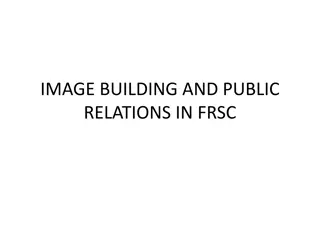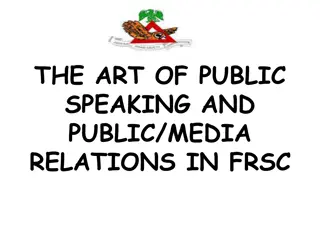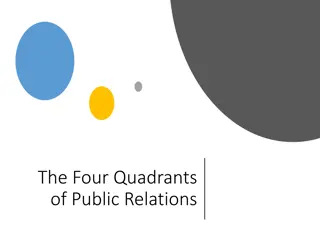Evolution of Public Relations: From Stonewalling to Modern Approach
The history of public relations traces back to the 19th century when press agents acted as barriers between companies and media. Initially unpopular, PR evolved during the 20th century with the pioneering work of Ivy Lee, promoting a transparent and communicative approach for companies. The shift from stonewalling to proactive communication marked a significant turning point in PR practices.
Download Presentation

Please find below an Image/Link to download the presentation.
The content on the website is provided AS IS for your information and personal use only. It may not be sold, licensed, or shared on other websites without obtaining consent from the author. Download presentation by click this link. If you encounter any issues during the download, it is possible that the publisher has removed the file from their server.
E N D
Presentation Transcript
PUBLIC RELATIONS A HISTORY
PUBLIC RELATIONS The modern idea of public relations in the United States is fairly recent 20thcentury. The idea of working with the news media, giving them story ideas, and relating openly to their questions to improve goodwill toward a company that was not part of 19th-century thinking.
PR UNPOPULARITY Not only was PR unpopular among businesses, it also was unpopular among news media. Reporters traditionally mistrusted flaks who misled reporters into publishing promotional material, or did not tell reporters the truth.
PR BEGINNINGS Actually, however, public relations was an advancement over the old way of doing things. The idea of a press agent did exist in the 19th century. But this kind of agent usually existed not to help the media, but to block it. The agent acted as a wall between the company and the media, to keep secrets and block reporters trying to get information from company leaders.
PRESS AGENTS Old-style press agents usually did not provide press releases or other material to the media. This was because most companies could see no good reason to deal with the media at all. It was up to the newspapers to get information, not to businesses, who would not easily give it.
STONEWALLING Should a company be involved in some kind of disaster or scandal, the press agent s job was to stonewall. That is, he would try to keep any news secret, and tell reporters nothing.
A NEW APPROACH Around the turn of the century, 1900, a new idea developed. Advocates of new PR suggested that when a company was faced with a need to communicate, it should not stonewall, because that would not increase goodwill for the company. The most famous proponent of modern PR was Ivy Ledbetter Lee.
IVY LEE Lee, an 1899 Princeton graduate, began work for New York newspapers. But he decided to leave to try something new a public relations bureau, called Parker and Lee. (George F. Parker was a Buffalo, N.Y., journalist.) He brought to his new business his knowledge of what reporters need from public relations people.
IVY LEES IDEALS Lee said PR practitioners needed to practice openness with media. His motto: Accuracy. Authenticity. Interest. He argued for an honest, open approach.
PENNSYLVANIA RAILROAD The 1906 Pennsylvania RR incident gave him the opportunity to test his new concept. Railroads at this time were the most powerful businesses in the United States. But moving goods and people from one place to another occasionally led to accidents. After a railroad accident, the typical company response was to try to suppress news of the incident. Lee thought this ought to change.
RAILWAY ACCIDENT AND PR In response to the Pennsylvania Railway accident Lee, who represented the company, did the unexpected. Lee actually invited reporters to the accident scene at company expense. This approach was popular with reporters, who now were spoiled. They expected other companies to do this as well.
ANOTHER RAIL ACCIDENT So when New York Central Railway responded to a later accident with the usual secrecy, reporters got angry and gave it negative coverage. Lee s insistence on absolute frankness with the media changed the way American industry dealt with the public.
COAL STRIKE A year before, a miners union hired Lee to represent the group in a coal strike. He tried something new: a press release. Journalists were skeptical. In response he emphasized the difference between PR and advertising: This is not a secret press bureau. All our work is done in the open. We aim to supply news. This is not an advertising agency. If you think any of our matter ought properly to go to your business office, do not use it. Our matter is accurate.
LEE AND ROCKEFELLER Lee became famous for his public relations experience representing John D. Rockefeller, one of the era s great tycoons. Rockefeller was famously aloof. Lee urged him to appear in public more often, mill about with his employees, and so look more human. Rockefeller s union-busting and trust-building by this time had turned him into one of the country s most hated men. Lee had a challenge.
LEE AND ROCKEFELLER Rockefeller took his advice, and did manage to improve his image. He became particularly remembered for appearing in front of children in orphanages, and giving out dimes. By the time he died in 1937, he had given away a fortune, was often seen in public, and died as a fairly well-liked public figure.
THE TRUTH Lee believed public relations practitioners should tell the truth, never try to deceive, and never, ever offer payments to the press to publish non-advertising material a common tactic at the time. Businesses might pay a newspaper for running an article, while the newspaper would not disclose the article was paid for. Lee believed this was unethical.
EDWARD BERNAYS At about the same time, Edward Bernays grew to become the other most significant figure in U.S. public relations development. Bernays was Sigmund Freud s nephew. He grew up steeped in the new ideas regarding the power of the unconscious, and the irrational, emotional nature of people s thinking and motivations.
EDWARD BERNAYS Bernays did agree with Lee s principles. But he wrote three influential books arguing for the essentially irrational responses people make to PR, and other communication. Bernays also considered the principles of modern of propaganda.
BERNAYS AND WORLD WAR I After World War I, Bernays and his ideas based on Freud became more accepted in the highest circles. President Woodrow Wilson invited him to the Paris peace conference in 1919.
BERNAYS AND HISTORY Bernays somewhat bleak assessment of public irrationality relating to persuasive techniques seemed to be vindicated after Adolph Hitler s Nazi party used such techniques to great success in 1930s Germany.
LEE VS. BERNAYS Lee was less pessimistic. Lee said pubic opinion was not irrational, but only interested in self-gain. The terms propaganda and public relations were more interchangeable then than they are today. Lee said both public relations and propaganda were merely the effort to propagate ideas. He felt both were all right, as long as the public knew the source of the ideas.
DISILLUSIONMENT But Lee was like many journalists after World War I disillusioned by propaganda power and facts. Lee claimed there was no such thing as facts, just personal interpretation of facts. This meant presentation of information depended on who presented it; every fact was colored.
FACTS AND BERNAYS Bernays agreed with Lee on both the nature of facts and the nature of people s self-interest. Bernays further emphasized people clearly held opinions for irrational reasons. Neither public relations pioneer, obviously, held a very optimistic viewpoint regarding public opinion. Lee died in his 50s, of a brain tumor. Bernays lived to an amazing 103, dying in 1995.
PUBLIC RELATIONS AND WAR Both men were influenced by the success of propaganda/public relations efforts in World War I. That success, as we discovered earlier, led to discredit of propaganda. Bernays ideas added to the discredit, and the distrust of public relations as it was confused with propaganda.
THE ATROCITY STORIES Propaganda stories of German atrocities during the First World War were universally believed and they inflamed public opinion to high levels of hate against the enemy. But after the war the public discovered many of these stories had been made up. They felt manipulated.
ATROCITY AND WORLD WAR II So when in the late 1930s atrocity stories started to come from Nazi Germany describing concentration camps and extermination of Jews, homosexuals or disabled people skeptical Americans often didn t believe. Sources were crying wolf. This time, however, the propaganda was only too tragically true.
WORLD WAR I AND PR The success of World War I PR influenced by those who were amazed by its power, and those who feared it. In particular, journalists became fearful. Editor and Publisher attacked public relations as simply a way for business to promote for free what should be paid advertising.
THE MENACE Bernays public relations is still considered today to be among the most influential ever seen in the United States. However, some mass media research has begun to question some of the influence suggested in this video.
AMBIVALENCE Reporters and editors were ambivalent. On the one hand they were disgusted or embarrassed by PR people. On the other hand, they appreciated the helpfulness and usefulness of PR people. News people even before the development of PR long used ready-made interviews, canned speeches and other material from institutions and organizations.
WHY THE DISTRUST? Why did journalists so distrust PR people? Perhaps because at based it threatened the very idea of reporting. Instead of reporting events, you are reporting those facts provided to you from the point of view of the PR people. If that were the case, Lee was right: there are no facts, only interpretations.
CAMPAIGNS Journalists also were worried about PR campaigns. These could manufacture news. For example, Lee publicized Rockefeller s donation to Johns Hopkins University. It was widely covered. Lee commented later to Rockefeller that it was not news, yet the newspapers paid so much attention to it. Success of that campaign Lee attributed was to the image (not the facts) the PR people were able to create.
CREATING NEWS Bernays agreed with Lee that PR people were creating news. Despite media misgivings, PR become more and more popular. Government agencies and businesses all hired public relations people. Despite distrust from both business and media, PR clearly was useful.
PUBLIC RELATIONS GROWTH Today the majority of businesses have public relations staffs. A large number of what used to be called J-School grads go into public relations. It s become a respectable major available in many communication programs. But many people nevertheless view public relations as a slightly tainted profession because it involves a clear bias and possible skewing, or spinning of the facts.
OBJECTIVITY? We know today that objectivity is really hard to attain. Still many people don t like to see obvious bias from the PR side. However, today we also know PR doesn t necessarily have the kind of power Bernays or Lee might have believed. Nevertheless, in the right situation we know it has a strong influence.
FOR GOOD OR NOT? Is it a good or bad thing for society that this formalized, professional industry dedicated to persuasion has indeed become so persuasive in our culture?























